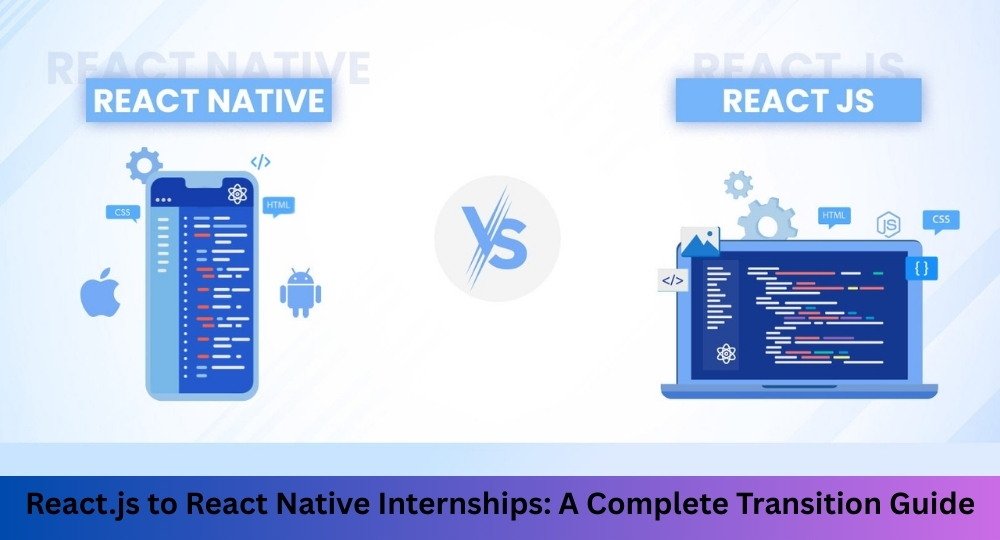React.js to React Native Internships: A Complete Transition Guide

If you’re a React.js developer looking to expand into mobile app development, transitioning into a React Native internship might be the perfect move. The tech world is rapidly shifting toward mobile-first solutions, and companies are on the hunt for developers who can seamlessly bridge the gap between web and mobile platforms.
In this guide, we’ll break down everything you need to know—from the similarities and differences between React.js and React Native, to how you can prepare for and secure an internship.
Understanding the Basics
What is React.js?
React.js is a JavaScript library built by Facebook for creating interactive UIs for web applications. It’s loved for its component-based structure, reusable code, and efficiency in handling dynamic data.
What is React Native?
React Native, also built by Facebook, extends the principles of React to mobile app development. Instead of building web apps, you build mobile apps that run on both Android and iOS using JavaScript and React concepts.
Key Similarities
- Both use components and props
- Both rely on state management and hooks
- Both encourage code reusability
Why Transition from React.js to React Native?
The question isn’t “why should you transition?” but “why not?” Here’s why:
- Career growth: Mobile development offers new job roles and higher salary packages.
- Skill expansion: Learning React Native allows you to work across platforms.
- Industry demand: Many startups and enterprises are switching to React Native for cost-effective cross-platform apps.
Core Differences You Need to Know
Web vs. Mobile
React.js runs on browsers, while React Native runs directly on mobile devices.
Styling
React.js uses CSS; React Native uses a style system closer to inline JavaScript styling.
Navigation
Instead of React Router, React Native uses libraries like React Navigation.
Device APIs
You’ll interact with hardware features like GPS, camera, and accelerometer—something web apps rarely do.
Transferable Skills from React.js
Your React.js background won’t go to waste. Skills like:
- Components & Props: The heart of both frameworks.
- State & Hooks: Managing app logic remains the same.
- Reusable Code Logic: You can carry over utilities, business logic, and even custom hooks.
New Skills You’ll Learn in React Native
Transitioning will expose you to:
- Native Components like <View> and <Text> instead of <div> and <p>.
- Libraries like Expo and React Native Elements.
- Gestures & Animations using React Native Gesture Handler or Reanimated.
- Platform Optimizations such as writing platform-specific code for Android and iOS.
Technical Requirements for Internships
Before applying, make sure you’re comfortable with:
- JavaScript & ES6 concepts
- Node.js and npm/yarn
- Version control (Git/GitHub)
- Tools like Expo, Android Studio, Xcode
Building Your First React Native App
Start small.
- Install Node.js and Expo CLI.
- Run npx create-expo-app myFirstApp.
- Open in Android Studio or scan the QR code to run on your phone.
- Build a “Hello World” app and deploy it to both Android and iOS simulators.
Challenges During Transition
Expect hiccups like:
- Confusing React.js with React Native syntax
- Debugging crashes on physical devices
- Performance bottlenecks if you don’t optimize images, assets, or APIs
Internship Preparation Tips
- Showcase projects: Convert your React.js projects into mobile apps.
- Create mini-apps: Weather app, To-do list, or Chat app.
- Polish your GitHub: Recruiters love seeing active commits.
How to Find React Native Internships
- Job boards: Internshala, LinkedIn, AngelList, Indeed
- Networking: Join React Native communities on Slack, Discord, or GitHub
- Open-source: Contribute to React Native libraries—great portfolio boosters
Interview Preparation for React Native Internships
Recruiters may test:
- Technical knowledge (state, props, navigation)
- Practical coding (build a simple screen or navigation flow)
- Soft skills (communication, teamwork, problem-solving)
Career Path After an Internship
After your internship, opportunities include:
- Mobile Developer (Android/iOS with React Native)
- Hybrid Developer (React.js + React Native roles)
- Freelance & Startup Roles with flexible projects
Real-World Applications
React Native is trusted by big names like:
- Walmart
- Uber Eats
Startups also prefer React Native due to lower costs and faster development cycles.
Conclusion & Key Takeaways
Transitioning from React.js to React Native isn’t as intimidating as it seems. With your existing React knowledge, you already have a strong foundation. All you need is exposure to mobile-specific tools, libraries, and design patterns. With practice, projects, and the right preparation, landing a React Native internship can open the door to a thriving mobile development career.
FAQs
1. Can I transition without prior React.js experience?
It’s possible, but React.js provides the best foundation for understanding React Native concepts.
2. How long does it take to learn React Native after React.js?
On average, 2–3 months of consistent practice is enough to feel confident.
3. What salary can I expect after an internship?
In India, React Native interns typically earn between ₹10,000–₹25,000 per month, depending on the company.
4. Is Expo necessary to learn React Native?
Not strictly, but Expo simplifies setup and development for beginners.
5. What projects should I build to land an internship?
Build practical apps like a weather app, e-commerce store, or chat app to showcase your skills.
Comments
Post a Comment